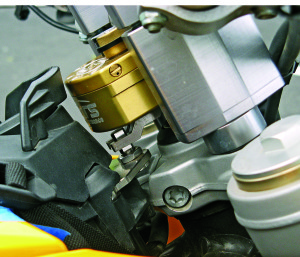Most riders would list excitement as a reason they ride, but there are some thrills we can all do without. Whacking a rock mid-corner or nailing a pothole while leaned over come to mind. That weird wobble you get when finding an uneven pavement seam isn’t much fun, either. So it’s no wonder I’ve been enjoying the Scotts steering stabilizer on my BMW F 800 GS so much—it’s had a big effect on front end control in every kind of riding, from the smoothest tarmac twisties to rock-studded washboard. This magic little box—really a hydraulic shock absorber—attaches to a bike’s triple clamp and connects to the steering head by a post that engages a lever on the stabilizer. Sudden deflections move the lever, which pushes oil through the internal valve circuits to damp the shock. Result? Both the bike and rider maintain their composure.
Three valve systems inside the stabilizer apply separate controls to the steering, with the base control valve subduing the normal hits and wobbles. The knob with the pointer adjusts the base control’s resistance in 24 steps. Road getting rougher? Turn the knob for more help. Hitting potholes at full tilt? That’s where the high-speed circuit comes into play. The adjuster screw lives beneath a black plastic cap. Small screws on either side change the sweep control, which determines how far from center the other circuits operate. Choices are 34, 44, 54 and 90 degrees. Note that with offroad stabilizers like the one tested here, damping only occurs away from center and doesn’t affect return to center. Scotts street stabilizers apply damping in both directions.

My GS uses Scotts’ SUB (Stabilizer Under Bars) mount, which adds an inch to the handlebar height to make room for the unit. Installation went smoothly, thanks to detailed instructions and plenty of clear photographs, plus a special tool to remove the key switch security screws. I had to trim some plastic from the ignition cover, but it’s not noticeable.
I tested the stabilizer on a nine-day adventure ride, immediately noticing that my quarter-ton dual-sport was easier to handle, both on and off the pavement. Smacking a rock while out of shape in deep gravel made me a believer. Instead of a big twist on the bars followed by the thud of the GS hitting the ground, the bike pushed the rock aside and I motored on. Similar scenes played out in rocks, sand, ruts and river crossings, and for the first time on a trip like this, my GS stayed upright the entire time.
Later, with my GS wearing street-oriented tires, I rode some favorite fire roads looking for things to hit while gradually cranking up the base resistance and tweaking the high-speed circuit. Once again, the Scotts kept the bike steady over everything I pointed it at. It almost felt like cheating. The final tests were riding one-handed through a rough patch of dirt road, then backing off the base valve and carving some super tight paved turns. The Scotts kept the front end steady through quick transitions without any extra effort on my part. While I can’t claim that the stabilizer has made me a better rider—only practice can do that—there’s no doubt that it’s made me a more confident one. And for the price of another mounting kit, I can move it to my DR-Z400S. Stabilizer prices vary by motorcycle; the stabilizer and SUB mount tested here retail for $569. Seems like a lot…until you hit something.
For more information, call (818) 248-6747 or visit scottsonline.com
(This Gearlab story was published in the September 2012 issue of Rider magazine.)







